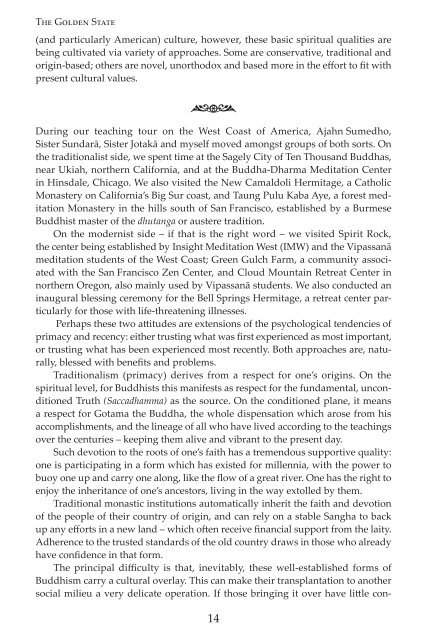Rugged Interdependency - Amaravati Buddhist Monastery
Rugged Interdependency - Amaravati Buddhist Monastery
Rugged Interdependency - Amaravati Buddhist Monastery
- No tags were found...
You also want an ePaper? Increase the reach of your titles
YUMPU automatically turns print PDFs into web optimized ePapers that Google loves.
The Golden State(and particularly American) culture, however, these basic spiritual qualities arebeing cultivated via variety of approaches. Some are conservative, traditional andorigin-based; others are novel, unorthodox and based more in the effort to fit withpresent cultural values.•During our teaching tour on the West Coast of America, Ajahn Sumedho,Sister Sundarā, Sister Jotakā and myself moved amongst groups of both sorts. Onthe traditionalist side, we spent time at the Sagely City of Ten Thousand Buddhas,near Ukiah, northern California, and at the Buddha-Dharma Meditation Centerin Hinsdale, Chicago. We also visited the New Camaldoli Hermitage, a Catholic<strong>Monastery</strong> on California’s Big Sur coast, and Taung Pulu Kaba Aye, a forest meditation<strong>Monastery</strong> in the hills south of San Francisco, established by a Burmese<strong>Buddhist</strong> master of the dhutanga or austere tradition.On the modernist side – if that is the right word – we visited Spirit Rock,the center being established by Insight Meditation West (IMW) and the Vipassanāmeditation students of the West Coast; Green Gulch Farm, a community associatedwith the San Francisco Zen Center, and Cloud Mountain Retreat Center innorthern Oregon, also mainly used by Vipassanā students. We also conducted aninaugural blessing ceremony for the Bell Springs Hermitage, a retreat center particularlyfor those with life-threatening illnesses.Perhaps these two attitudes are extensions of the psychological tendencies ofprimacy and recency: either trusting what was first experienced as most important,or trusting what has been experienced most recently. Both approaches are, naturally,blessed with benefits and problems.Traditionalism (primacy) derives from a respect for one’s origins. On thespiritual level, for <strong>Buddhist</strong>s this manifests as respect for the fundamental, unconditionedTruth (Saccadhamma) as the source. On the conditioned plane, it meansa respect for Gotama the Buddha, the whole dispensation which arose from hisaccomplishments, and the lineage of all who have lived according to the teachingsover the centuries – keeping them alive and vibrant to the present day.Such devotion to the roots of one’s faith has a tremendous supportive quality:one is participating in a form which has existed for millennia, with the power tobuoy one up and carry one along, like the flow of a great river. One has the right toenjoy the inheritance of one’s ancestors, living in the way extolled by them.Traditional monastic institutions automatically inherit the faith and devotionof the people of their country of origin, and can rely on a stable Sangha to backup any efforts in a new land – which often receive financial support from the laity.Adherence to the trusted standards of the old country draws in those who alreadyhave confidence in that form.The principal difficulty is that, inevitably, these well-established forms ofBuddhism carry a cultural overlay. This can make their transplantation to anothersocial milieu a very delicate operation. If those bringing it over have little con-14
















